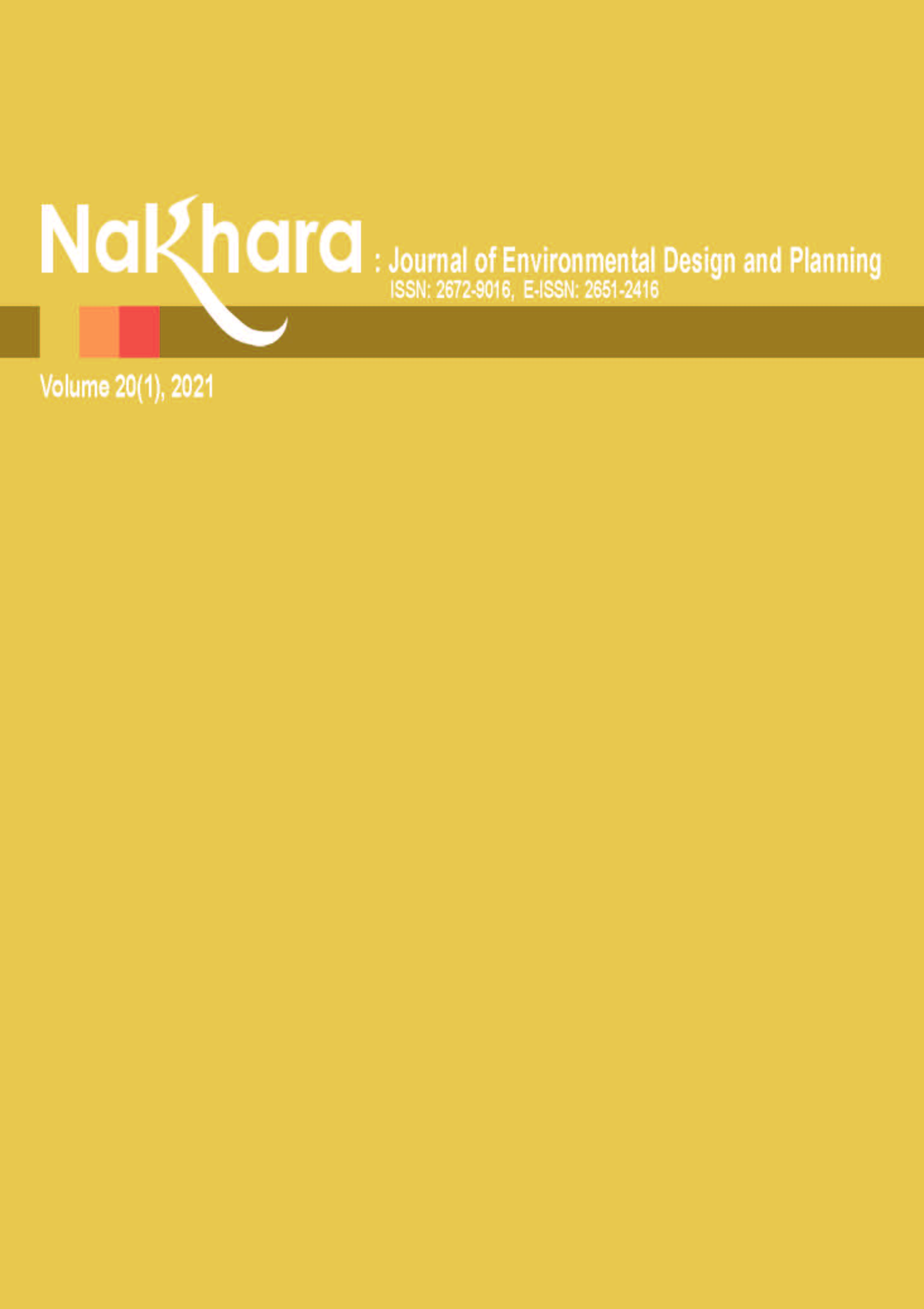Attachment and Associational Dimensions in the Architecture of Historical Building Conversion in Thailand Between 1997 and 2012
Main Article Content
Abstract
The research on The Initial Survey of Evolution of Adaptive Reuse of Historic Buildings in Thailand is aimed at constructing knowledge for the module named Reuse and Rehabilitation of Historic Buildings. This module is part of the curriculum of Bachelor of Architecture, which studies the role of architecture fabricated within historical buildings. In the era between 1997 and 2012 in Thailand, there was a notable transformation from conservation to contemporary conversion. A review of conservation perspectives indicates a combined multi-disciplinary cooperation between architectural design and conservation. To establish issues regarding the knowledge of conversion, a research question is raised: how do architectural elements play its role through changing of use? Aimed at understanding the complexity among conversion ideologies, issues surrounding architectural elements of historical buildings are rationally explored. Based on significant conversion projects from 1996 to 2012, architectural elements were referenced as to how concepts and objectives were associated. Qualitative research was conducted through a study of primary sources; survey and classification of representative samples, and secondary documents, records and architectural drawings. The controlling significance of the buildings led to a discussion and an analysis of the architectural designs through new additions and amendments made on the historical fabric. Included in this discussion are the principles of conversion as they relate to the architecture of historic buildings and the ideology of the modification. It is found that understanding a change to architectural elements through an ontological perspective, that of attachment and associational approaches, could clearly reveal the construction programme that felicitates the historical building for which conservation or adaptation is determined. A dialogue on relevant contexts surrounding amendments of architectural elements demonstrated that a strong emphasis towards particular objectives of use could coincidentally harm the historical building’s architectural dimension framework. This leads to the notion that architecture for adaptive reuse should include knowledge of the original construction, a balance among conditions of the existing building, its programming and further habitation.
Article Details

This work is licensed under a Creative Commons Attribution-NonCommercial-NoDerivatives 4.0 International License.
References
ASTV Manageronline. (2005). Phiphitthaphan kānrīanrū hǣng chāt kamnœ̄t mai samit sōnīan mư̄ang thai [Natioanal Learning Museum New Born of Smithsonian Thailand] http://www.manager.co.th/Daily/ViewNews.aspx?NewsID=94800000
Blagojevic, M. R. (1997). Basic typology of the public buildings presented on the examples built in Belgrade in period between 1830 -1900. Architecture and Civil Engineering, 1(4), 509-511.
Boonprasong, P. (2016, 19-20 December). The development of adaptive Use of historic building in Thailand [Paper presentation]. International Conference on Research and Design in Architecture and Related Fields, Silpakorn University, Bangkok, Thailand.
Boonprasong, P. (2017). Use transformation process of shophouses: A case study of the Tha Tien's shophouse, Bangkok [Doctoral thesis, Chulalongkorn University, Bangkok, Thailand]. CUIR. https://cuir.car.chula.ac.th/handle/123456789/58238
Brand, S. (1995). How buildings learn: What happens after they’re built. Penguin Books.
Cantacuzino, S. (1975). New uses for old buildings (1 ed.). Architectural Press.
Clark, K. (2001). Informed conservation: Understanding historic buildings and their landscapes for conservation. English Heritage.
Cramer, J., & Breitling, S. (2007). Architecture in existing fabric: Planning, design, building (1st ed.). Birkhäuser Architecture.
Cullinane, J. J. (2012). Maintaining and repairing old and historic buildings. Wiley.
Cunnington, P. (1988). Change of use: The conversion of old buildings. Alphabooks.
Feilden, B. (2003). Conservation of historic buildings (3 ed.). Architectural Press.
Giebeler, G., Krause, H., Fisch, R., Musso, F., Lenz, B., & Rudolphi, A. (2009). Refurbishment manual: Maintenance, conversions, extensions (J. Liese, Ed.). Birkhäuser.
Latham, D. (2000). Creative re-use of building. Donhead.
Madanipour, A. (2017). Cities in time: Temporary urbanism and the future of the city. Bloomsbury Academic.
Mason, R. (2004). Fixing historic preservation: A constructive critique of "significance" Places, 16(1), 64-72. https://placesjournal.org/assets/legacy/pdfs/fixing-historic-preservation.pdf
Musikakhama, N. (1995). nǣo patibat nai kān sangūan raksā bōrānnasathān: tāmpha ra rāt banyat bōrānnasathān bōrānnawatthu læ phiphitthaphanthasathān hǣng chāt Phō̜.Sō̜. sō̜ngphanhārō̜isī kǣkhai phœ̄mtœ̄m Phō̜.Sō̜. sō̜ngphanhārō̜isāmsiphā [Guidance on practice works for preservation of historic monuments]. Fine Art Departmant.
Orbasli, A. (2008). Architectural conservation. Blackwell Science.
Plevoets, B., & van Cleempoel, K. (2011). Adaptive reuse as a strategy towards conservation of cultural heritage: A literature review. In C.A. Brebbia (Ed.) Structural studies, repairs and maintenance of heritage architecture XII (Vol.118, pp. 155-164). WIT Transactions on the Built Environment. https://www.witpress.com/elibrary/wit-transactions-on-the-built-environment/118/22728
Plevoets, B., & van Cleempoel, K. (2012, 28-28 March). Adaptive reuse as a strategy towards conservation of cultural heritage: A survey of 19th and 20th century theories [Paper presentation]. RIE International Conference 2012 Reinventing Architecture and Interiors: the past, the present and the future, Ravensbourne, London, England.
Plevoets, B., & van Cleempoel, K. (2013). Adaptive reuse as an emerging discipline: an historic survey. In G. Cairns (Ed.) Reinventing architecture and interiors: a socio-political view on building adaptation (pp. 13-32). Libri Publishers.
Rasmussen, S. E. (1964). Experiencing architecture. M.I.T. Press.
Strike, J. (1994). Architecture in conservation: Managing development at historic sites. Routledge.
Taggart, F., Thorpe, S., Wilson, L., & Prince’s Regeneration Trust (2006). The Regeneration through heritage handbook: how to use a redundant historic building as a catalyst for change in your community. Phillimore.
The Burra Charter:The Australia ICOMOS Charter for Places of Cultural Significance, 2013. http://openarchive.icomos.org/id/eprint/2145/
Tiesdell, S., Oc, T., & Heath, T. (1996). Revitalizing historic urban quarters. Architectural Press.
Tomback, D., Brennan, T., Campbell, R., Wheldon, A., Oliva, L., Cartwright, V., & Lock, G. (2017). Heritage work: A toolkit of best practice in heritage regeneration. Historic England. https://historicengland.org.uk/images-books/publications/heritage-works
Trisuriyathamma, P. (2016). panyā ʻanākhot [Future] (4 ed.). Openbooks.
Verheij, R. B. G. (2015). Villa Huisduinen - A Place for retreat - palimpsest in architecture [Master thesis, Delft University of Technology, Netherland]. TU Delf. http://resolver.tudelft.nl/uuid:715e2f60-603c-4656-9acb-9428bb917c2b
Voordt, D. v. d., & Wegen, H. v. (2005). Architecture in use: an introduction to the programming, design and evaluation of buildings. Architectural Press.
Yaldız, E., & Asatekin, N. G. (2016). Evaluations of cultural perception performance by users on the basis of re-use of monumental building: The case of Sivas’ Buruciye Madrasah. MEGARON / Yıldız Technical University, Faculty of Architecture E-Journal, 16(1). https://doi.org/10.5505/megaron.2016.66487

